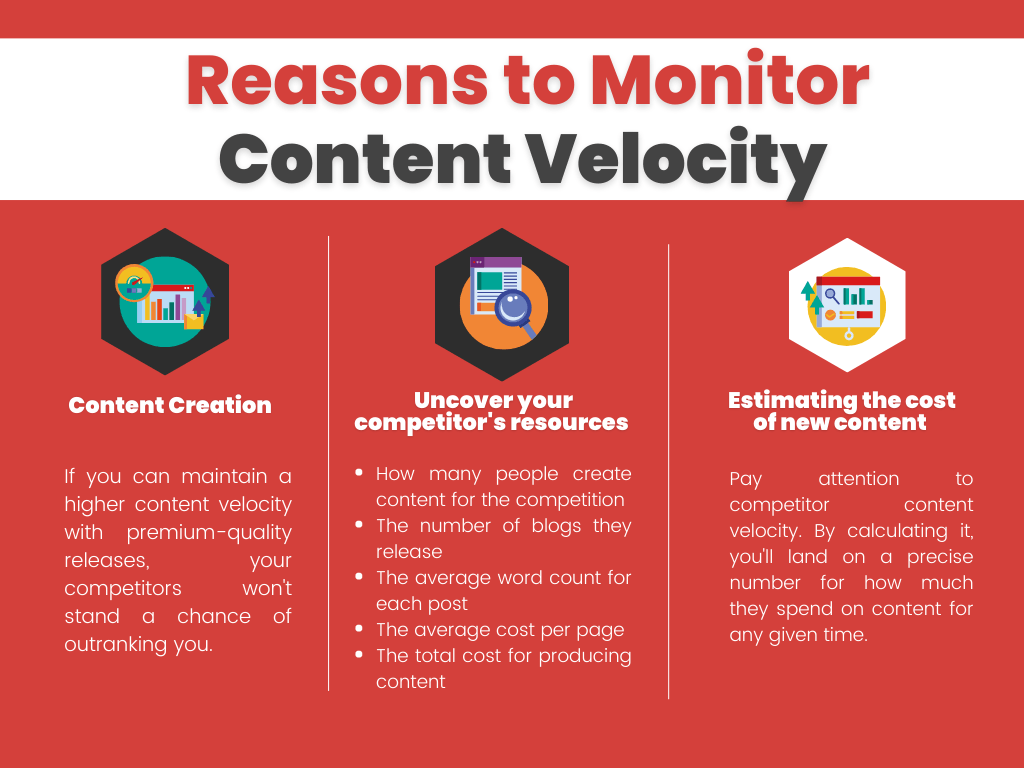Quick Links
Most SEO experts will tell you the same thing: quality always beats quantity when it comes to content creation. If you want to rank high in search engines, you should focus on creating a few stellar pieces of content instead of churning out hundreds of so-so articles.
While it’s true that you should always try to put out the best quality content possible, the classic ‘quality beats quantity’ adage fails to take into account one very important thing.
What’s that?
It’s that a large amount of content doesn’t have to be mediocre by default.
It’s possible to churn out high-quality content on a mass scale, and the companies that do so see incredible results.
That brings us to an essential SEO metric that’s often overlooked or completely ignored– content velocity.
It’s a valuable metric to monitor because search engines view websites with a higher content velocity as more authoritative. This is a fact confirmed by Google’s John Mueller, who states, “It’s hard to call a site authoritative with only 30 pieces of content.”
The quote goes against the ‘less is more mentality of the ‘quality over quantity adage.
So if you want Google to take your website seriously, you’ll need to engage in more frequent content production. You’ll enjoy the best of both worlds if you uphold high-quality standards for your releases.
Read on to learn more about content velocity, why it matters, and how to calculate it for your competitors.
What is Content Velocity?
Formally defined, your content velocity refers to the amount of content you release over a set period.
For example, how many blog articles do you release each week? If you write two, that’s your content velocity for the week. You can also set different time periods, such as per month, year, or quarter.
It’s a valuable metric to keep track of for your content marketing strategy, and it’s also wise to calculate the content velocity of your competitors.
For instance, checking and calculating their content velocity may uncover the answer if a competitor is outranking you. If you’re only releasing two high-quality blogs a week, but they’re releasing 5, they’ll likely outrank you, as well as generate more traffic, leads, and sales due to their heightened output.
Calculating content velocity is also an integral part of healthy content management, as it lets you know how much you’re spending on its production (as well as if you’re hitting your publish dates or not).
Why does content velocity matter?
Content is undoubtedly king in today’s age, but there’s been a bit of oversaturation in recent years.
Thousands of companies are all producing content, digital experiences, and digital assets across countless different channels. That’s begun to cause content fatigue of sorts among users, as what worked in the past won’t work now.
Modern users crave personalized content and engaging customer experiences that don’t only educate but also entertain.
There are:
- Blogs
- Videos
- Infographics
- eBooks
- Whitepapers
- Podcasts
- Vlogs
Besides these, there are countless other channels, which makes producing high-quality content at scale increasingly tricky.
That’s why it’s crucial to get a grasp of your content velocity to ensure you’re on the right track.
Not only could you not be producing enough content, but you could also be overproducing. Remember, you still want everything you release to be relevant, engaging, and purposeful for your audience, so spamming lots of useless articles isn’t a winning strategy.
Reasons to Monitor Your Content Velocity
Content velocity as a metric has many use cases, which is why you should start paying attention to it if you aren’t already.
We’ve already discussed how Google views higher content velocity as more authoritative, which is a big reason why you should aim to increase your velocity if it’s too low.
That poses a perplexing conundrum for new content creators, as you likely don’t have an extensive library of blogs, articles, and videos yet. Of course, you want to ensure your content lives up to your quality standards, but you also don’t want to get overlooked due to your lack of existing content.
That’s a big reason why you should calculate your content velocity as well as your competitors, as it will help you determine your budget as well as what you need to do to compete with other websites.
The primary reasons to monitor content velocity include the following:
- Convincing executives you need more resources for content
- Uncovering the resources your competitors have
- Estimating the cost of new content
Each of these reasons is important, so let’s take a closer look at each one.
Acquiring more resources for content creation
Are you not able to release the same types of content as your competitors? Maybe they’ve started robust video campaigns that you don’t have the resources to compete with.
If that’s the case, bring up the case to your executives.
Show them the content velocity of your top competitors, and let them know that they’re destroying you in the search rankings as a result.
If there’s one thing company executives can’t stand, it’s losing out to the competition. As such, they’re likely to give you the green light for more content creation, including all the resources you need to shoot high-quality videos.
Even if you’re not losing the race, you can still press the issue with your superiors that you need to stay ahead.
After all, if you take your foot off the gas, you’ll start to see your competitors in the rearview mirror in no time.
That’s why you should also convince executives to not only catch up to competitor release schedules but to leave them behind in the dust. If you can maintain a higher content velocity with premium-quality releases, your competitors won’t stand a chance of outranking you.
In short, never be shy about bringing up content velocity to executives and stakeholders to acquire more resources.
Uncovering your competitor’s resources
Not knowing the content creation capabilities of your competitors can be very frustrating. It can seem as if they have an infinite pool of resources at times.
If only there were a way to discover your competitor’s resources.
It turns out there is, and content velocity is the key to uncovering them. You’ll be able to determine how large their content creation team is, including any freelancers (writers, graphic designers, etc.).
By conducting an in-depth investigation, you’ll be able to discover the following:
- How many people create content for the competition
- The number of blogs they release each week, month, year
- The average word count for each post
- The average cost per page
- The total cost for producing content (per the time period given)
That’s invaluable information for coming up with ways to compete. If you can acquire the resources, it’s always best to outdo your competitor’s content velocity– not only for the authority boost but also for more traffic, leads, and sales.
With an in-depth competitor audit, you can uncover all sorts of valuable insights (more on this in a bit).
Estimating the cost of new content
Want to compete with competitor content that offers personalized digital experiences?
If so, you’ll need to estimate what it will cost to make it happen. You can do that by paying attention to competitor content velocity. By calculating it, you’ll land on a precise number for how much they spend on content for any given time.
That way, you’ll know precisely how much it will cost to create the same type of content.
If you find that you come up a little short, try the advice mentioned in the first tip– bring it up to your executives. They likely won’t want to be outdone by competitors, which gives you a fighting chance to land the resources you need to compete.
Remember, analyzing metrics isn’t always about finding things that were done right; it’s also about finding what competitors are doing wrong.
For instance, let’s say a competitor launched an expensive new video campaign promoting a new product.
Instead of blindly defaulting to monkey see, monkey do– dig a little deeper than that. In particular, take the time to see if users are actually engaging with their videos.
If the campaign is generating little to no interest or traffic, it’s not worth copying. By only mimicking tactics that your competitors found success with, you’ll avoid wasting valuable time and resources by copying their failures.
Calculating Content Velocity
Now that you know what content velocity is and why it matters, it’s time to learn how to calculate it.
This would be the part of the article where we share the simple, straightforward formula for determining content velocity.
The only problem is there isn’t a straightforward way of calculating content velocity, as it’s actually quite complex in most cases.
At its simplest, you can calculate it using only a few standard SEO tools, such as SEMrush and Screaming Frog.
At its most complex, it can involve hours of sorting through emails, infographics, and PPC ad copy.
It all comes down to how much content you have, as well as how many types. If the only type of content you have are blogs, calculating your velocity will be very simple. Yet, if you’re like most companies, you likely have a boatload of content spanning from blogs to client-nurturing emails.
The SEMrush/Screaming Frog method
Here’s a simple method you can try to calculate content velocity. First, you’ll need to uncover a website’s number of blog articles, which you can easily do with SEMrush‘s URL filter (show blogs only).
Export the list and head over to Screaming Frog for a custom data extraction. That will let you know when the blog articles were published, allowing you to calculate the content velocity.
Here are the extractions you should try:
- Metadata
- Blog posting schema
- Article schema
That should be enough to uncover the publish dates for the blog articles. You should also pay attention to the word count for each blog post.
Why is that?
It’s because knowing the word count will help you determine how much the company paid for each article.
Most copywriters and article-writing services charge $0.25 – $0.30 per word, which you can use to estimate their budget. So if a competitor has a blog that’s 1,000 words long, you can assume they paid anywhere from $250 – $300 to produce it.
Bear in mind that this technique will only calculate content velocity for blogs. To calculate it for other types of content, you’ll need to run them through SEMrush and Screaming Frog as well. For instance, you could set the URL filter to only show videos and repeat the same process.
Using Ahrefs
Besides using SEMrush and Screaming Frog, you can also use Ahrefs to calculate competitor content velocity.
In particular, their Content Explorer tool contains some valuable insights that you won’t find using the other method. To begin, bring up the tool and enter the URL of your competitor’s website.
Once you enter the period you’re tracking, you’ll get to see a complete breakdown of all the articles published within that time frame. You’ll also get to see the following:
- Exact release dates
- Word count
- Social shares
- Author name
- Pages over time (a graph showing how many pages they’ve released in their lifespan)
- Organic traffic
- Referring domains
- Domain rating
- Traffic value
As you can see, Ahrefs provides a ton of detailed metrics that are perfect for content velocity. You also get a metric for traffic value, which will save you from having to do any math. You also get to see the author’s name for each post, allowing you to unmask their content creation team.
Another technique for uncovering article authors is to check company LinkedIn profiles. If you dig a little deeper, you may be able to uncover the rates writers charge your competitors, which will make your budget estimate even more accurate.
Final Takeaways: Content Velocity in 2023
That’s an overview of content velocity and why it matters for your SEO strategy. While creating premium quality content is undoubtedly crucial, that doesn’t mean there’s no merit for a large quantity of content.
In fact, search engines like Google view established websites with a lot of content as more trustworthy and authoritative.
That’s why you should focus on generating a healthy quantity of content with high-quality standards.
You should regularly calculate content velocity for your own company and your competitors. That way, you’ll have a solid grasp of your competitors’ content strategy, as well as your own.
Would you prefer a company to handle your SEO strategy instead?
If so, please don’t hesitate to check out our five-star managed SEO services at HOTH X.












